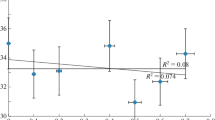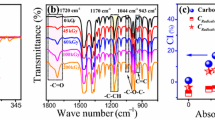Abstract—The stress–strain properties of radiation-modified polydicyclopentadiene synthesized by the PolyHIPE technology are studied. The dependence of the tensile strength on the absorbed dose follows a complex pattern. A rise in the dependence in the low-dose region, that is, in the range from 10 to 40 kGy, may be associated with the predominance of radiation crosslinking over degradation. With the increase in the absorbed dose above 40 kGy, the test material generally behaves as predominantly destructuring. Experimentally detected are the signs of tensile strength recovery in the dose range from 20 to 40 kGy to the corresponding values for the unirradiated sample, which indicates the enhanced strength properties of the material. When comparing the values obtained for the material irradiated with a dose of 40 kGy and the unirradiated material, it is clear that the tensile strength decreases by just 5%. It is found that, in the dose range from 0 to 10 kGy, degradation reactions dominate, leading to a low content of the gel fraction. With a further increase in the radiation dose, the intensity of crosslinking of macromolecules becomes higher than the intensity of degradation, which leads to an increase in the proportion of the gel fraction. In the range of 30–50 kGy, the character of this dependence indicates that radiation crosslinking predominates over degradation and it is maximal at a dose of 40 kGy, as follows from a small amount of the dissolved part of the polymer.



Similar content being viewed by others
REFERENCES
D. E. Fogg and H. M. Foucault, Compr. Organomet. Chem. III 11, 623 (2007).
I. Njoroge, P. A. Kempler, X. Deng, S. T. Arnold, and G. Kane Jennings, Langmuir 33, 13903 (2017).
S. T. Nguyen, L. K. Johnson, R. H. Grubbs, and J. W. Ziller, J. Am. Chem. Soc. 115, 9858 (1993).
M. S. Sanford, J. A. Love, and R. H. Grubbs, J. Am. Chem. Soc. 123, 6543 (2001).
T. M. Trnka, Acc. Chem. Res. 34, 18 (2001).
D. A. Rusakov, E. I. Korotkova, A. A. Lyapkov, O. I. Slavgorodskaya, and Yu. V. Dontsov, Fundam. Issled., No. 8, 700 (2013).
V. I. Irzhak, B. A. Rozenberg, and N. S. Enikolopyan, Cross-Linked Polymers (Nauka, Moscow, 1979) [in Russian].
Brief Chemical Encyclopedia, Ed. by I. L. Knunyants (Sovetskaya entsiklopediya, Moscow, 1990), Vol. 2 [in Russian].
S. Yang, Y. Wang, Y. Jia, X. Sun, P. Sun, Y. Qin, R. Li, H. Liu, and C. Nie, Colloid Polym. Sci. 296, 1005 (2018).
M. Yu. Matrosova and O. V. Litvinenko, in Proceedings of the All-Russian Forum of Scientific Youth “Bogatstvo Rossii”, Moscow, Russia,2018 (Izd-vo Mosk. Gos. Tekh. Univ. im. N. E. Baumana, Moscow, 2018), p. 168 [in Russian].
V. L. Auslender, V. V. Bezuglov, A. A. Bryazgin, L. A. Voronin, V. A. Gorbunov, M. V. Korobeinikov, V. E. Nekhaev, A. D. Panfilov, V. S. Podobaev, V. O. Tkachenko, A. A. Tuvik, and B. L. Faktorovich, Zh. Vestn. Nizhegorod. Gos. Univ. Ser. Fiz. 1 (2), 89 (2006).
S. Kovačič, F. Preishuber-Pflügl, and C. Slugovc, Macromol. Mater. Eng. 299, 843 (2014).
B. K. Keitz, A. Fedorov, and R. H. Grubbs, J. Am. Chem. Soc. 134, 2040 (2012).
M. Yu. Kozhanova, O. V. Litvinenko, P. A. Khakhulin, and I. S. Golubenko, Polim. Mater. Tekhnol. 4 (4), 59 (2018).
A. K. Fedotov, V. M. Anishchik, and M. S. Tivanov, Physical Material Science: Tutorial in Three Parts. Materials of Energy and Energy Saving (Vysheishaya Shkola, Minsk, 2015), Part 3 [in Russian].
W. B. Jensen, J. Chem. Educ. 84, 1913 (2007).
Funding
This work was partially supported by Small Business in Science and Technology Promotion Fund (“Umnik” Program, contract no. 13732GU/2018, April 1, 2019, Ulyanovsk oblast).
Author information
Authors and Affiliations
Corresponding author
Rights and permissions
About this article
Cite this article
Kozhanova, M.Y., Litvinenko, O.V., Khakhulin, P.A. et al. Dependence of the Mechanical Properties of Polycyclopentadiene Radiation-Modified with Accelerated Electrons on the Content of the Gel Fraction. Polym. Sci. Ser. B 61, 771–775 (2019). https://doi.org/10.1134/S1560090419050087
Received:
Revised:
Accepted:
Published:
Issue Date:
DOI: https://doi.org/10.1134/S1560090419050087




